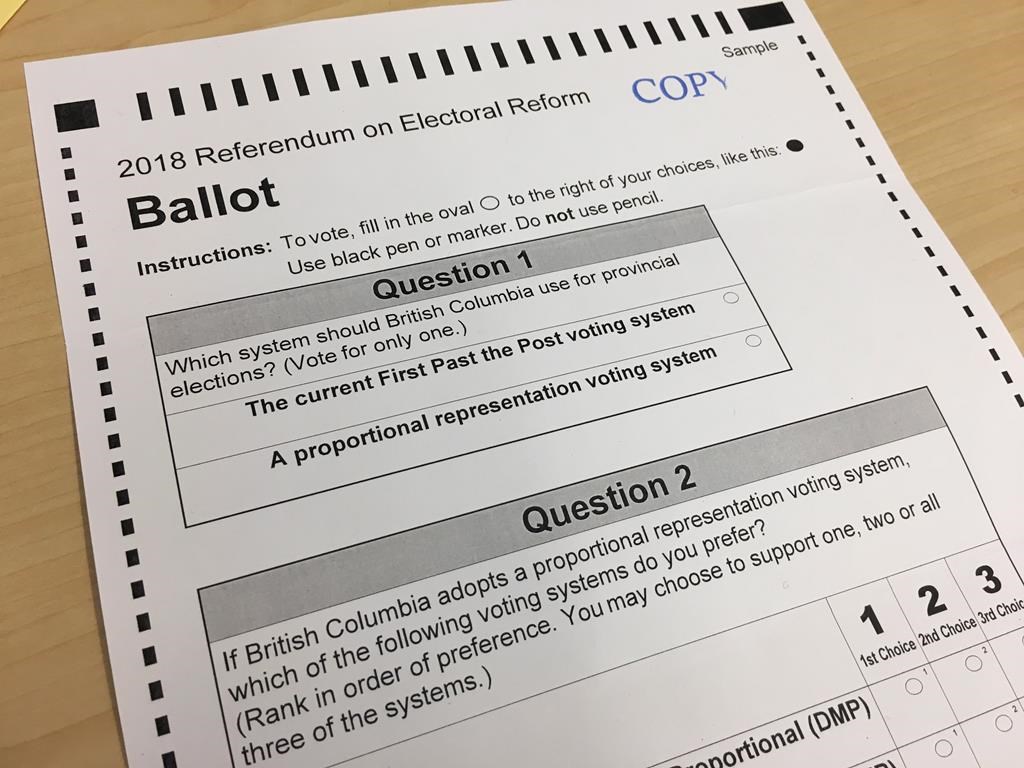Elections BC says that 597,300 electoral reform referendum ballots have now been received, a turnout of 18 per cent of registered voters. The turnout number took a big jump on Friday, up from 7.4 per cent on Thursday, because Elections BC has decided to change the way it is providing information to the public.

“Before today, the interim ballot package return report only included returned packages that had passed initial screening,” reads a statement from Elections BC. “Today’s overall estimate also includes packages on hand at Elections BC’s facilities waiting to be processed, as well as packages undergoing initial processing prior to screening.”
The change comes as criticism builds over a low voter turnout in the referendum. Voters have until Nov. 30 for their ballot to be received by Elections BC.
The outgoing, rolling strikes at Canada Post has also meant ballots have not been picked up and thousands of ballots are still sitting in Canada Post’s warehouse. The updated numbers provided by Elections BC on Friday do not include ballot packages that have been received by Canada Post and not yet transferred to Elections BC.
WATCH HERE (aired Nov. 15, 2018): Low returns in B.C.’s electoral reform referendum

Premier John Horgan and Green Party Leader Andrew Weaver are set to host a “day of action” on Sunday where they will accompany supporters to a nearby mailbox to mail referendum ballots.
Horgan was asked on Thursday about the low voter turnout and whether there was a certain threshold that was needed to put aside any concerns about the legitimacy of the referendum results. The provincial government decided to not put any turnout requirements, like in general elections, on the referendum.
LISTEN: Friday morning there was a Reddit Ask-Me-Anything on proportional representation. The experts was Richard Johnston a UBC political scientist:
“Certainly, I want to see as much participation as possible. We have seen referenda in the past that has seen turnout of 40, 50 per cent,” Horgan said on Thursday. “There were some Canada Post issues at the beginning. Now that the debate is over, I am confident the votes will be flooding in.”
UBC professor Richard Johnston told CKNW host Lynda Steele there should not be minimum threshold because it would create “cynical politicking.” But Johnston says there is no question that if there is a low turnout, there will be lots of politicking about what that means for legitimacy.
“This is a very consequential choice. It will change the way that government proceeds. I think it is highly likely that we would see more parties in the legislation. I think it is highly likely we would never see single-party majorities again,” Johnston said.
The low turnout and the ongoing postal dispute have led the No BC Proportional Representation Society to ask Elections B.C. to extend the deadline to return ballots. Currently, ballots must be returned by 4:30 p.m. on Nov. 30.
WATCH HERE (aired Nov. 9, 2018): Proportional Representation for Dummies

“We are voting on a fundamental aspect of our democracy – the system by which we choose our elected representatives and our government – that should not be changed by a tiny fraction of voters in a close result,” No PR Society head Bill Tieleman said.
“The last two referenda on electoral systems in 2005 and 2009 and the Harmonized Sales Tax referendum in 2011, all had turnouts above 50 per cent – but we are nowhere near that with just two weeks left to go.”




Comments